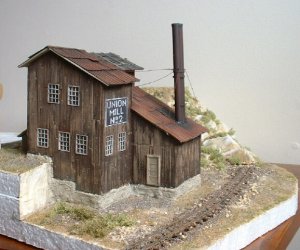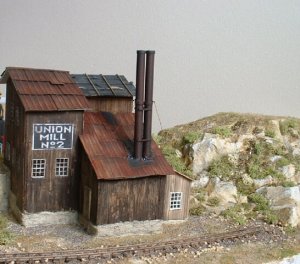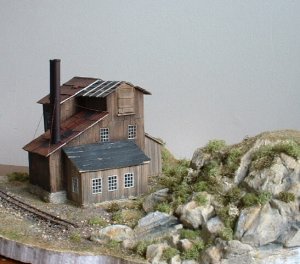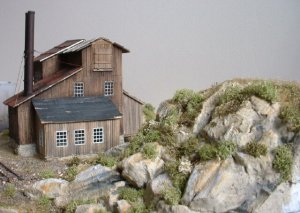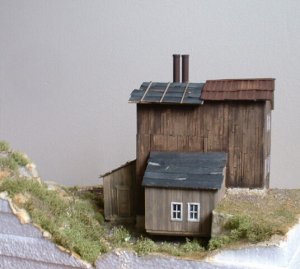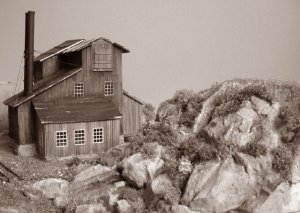Thanks everyone. Some basics on the structure... This is an HO model, built board-by-board over a basswood framework. The windows and doors are Grandt Line (I think), and the pressed metal roofing material is made from cardstock. I may at some point go back and replace the roof with another medium, but for now I'm satisfied. The smoke stacks are just styrene, with cardstock details. The support cables are thread stiffened with white glue and paint, and are attached to very fine eyebolts in the smokestack and roof of the structure.
The entire structure was painted with an alcohol-india ink wash, and the main part of the building was then overpainted with dark brown craft acrylic. When this paint was just dry to the touch, I used a metal wire brush to remove much of the paint. I've found that this is the best way to present heavily weathered and peeling paint.
The sign was a major pain. I tried homemade decals and hand painting, but couldn't get it right. Finally, I hand drew the sign on graph paper, scanned it into photoshop and fiddled around with stretching the image until it looked right, and then printed it on thin typing paper run through a regular inkjet. This makes a sign that's thin enough that it settles into the wood grain and looks painted on. Once everything was dried for a couple of days, I also passed the wire brush lightly over the sign to blend the edges and add some weathering.
The landscaping is on a basic foam base. I know that the use of white styrofoam is heresy, but I've been using it anyway. To cut, I use a cheap hot wire cutter sold in Michael's craft store for flower arrangers (this incidently, was a great purchase -- cost $7 as opposed to the big bucks for hot wire cutters, and runs on 2 D batteries). All of the rocks and boulders were carved with the hot wire cutter and then glued in place. I then covered the whole scene in Durham's water putty; just before the putty set, I stippled the entire scene with a regular paint brush to give it texture. Coloring was through a series of about 6 washes of acrylic craft paint.
I had some struggles finding something that looked right for sagebrush. Eventually, I ended up just using the fine tips of lichen, and I think it probably looks as good as anything. Ground foam and various experiements with WS products just never cut it. The rest of the ground cover is a mixture of fine ground foam, fine fibers cut 1/16 inch long from jute twine, and a variety of small rocks and ballast. In working on the landscaping, I kept thinking how very simple, traditional, and inexpensive techniques could produce really good looking results.
Like I said, eventually I'm going to need to add a lot more details. I obviously need loading docks and staircases, some industrial junk piles, a trestle, and smoke jacks on some of the side buildings. I'll also be building a small water tank to sit in the left rear of the scene.
Hope this fills in some of the blanks, and thanks again to everyone for the comments/encouragement.


